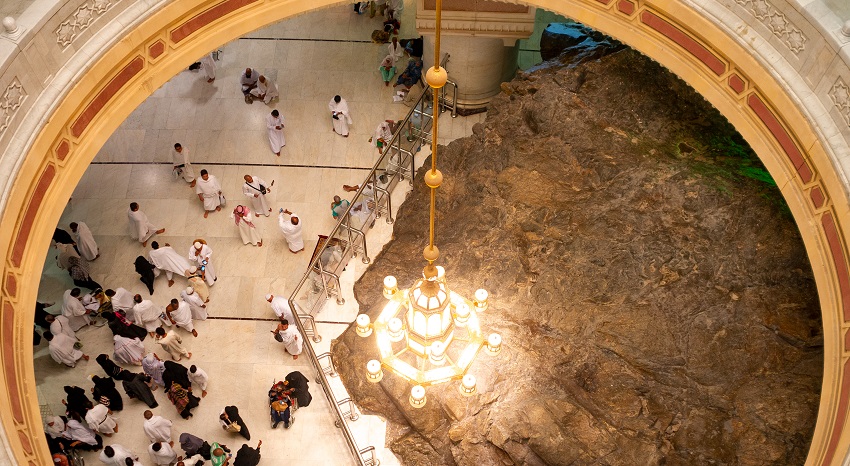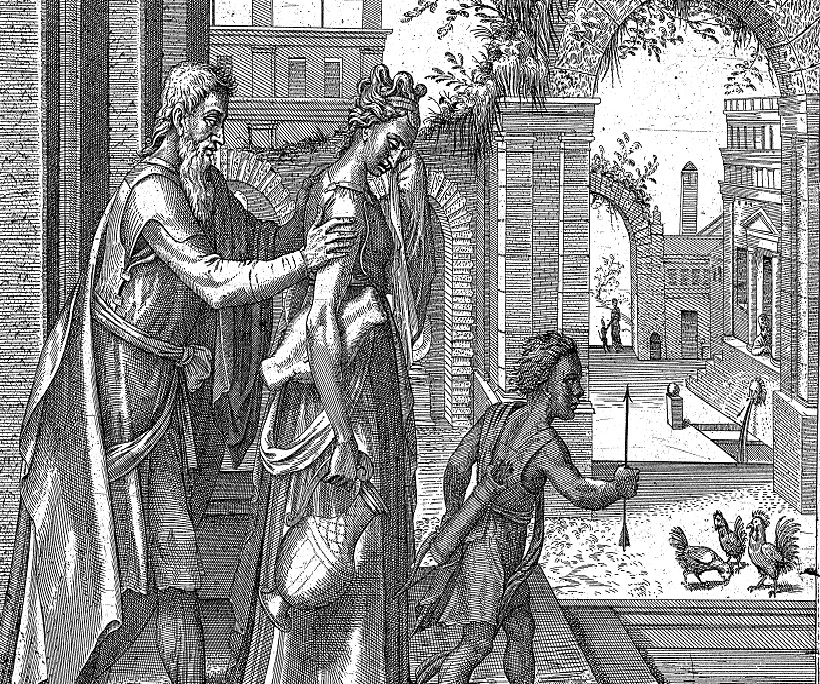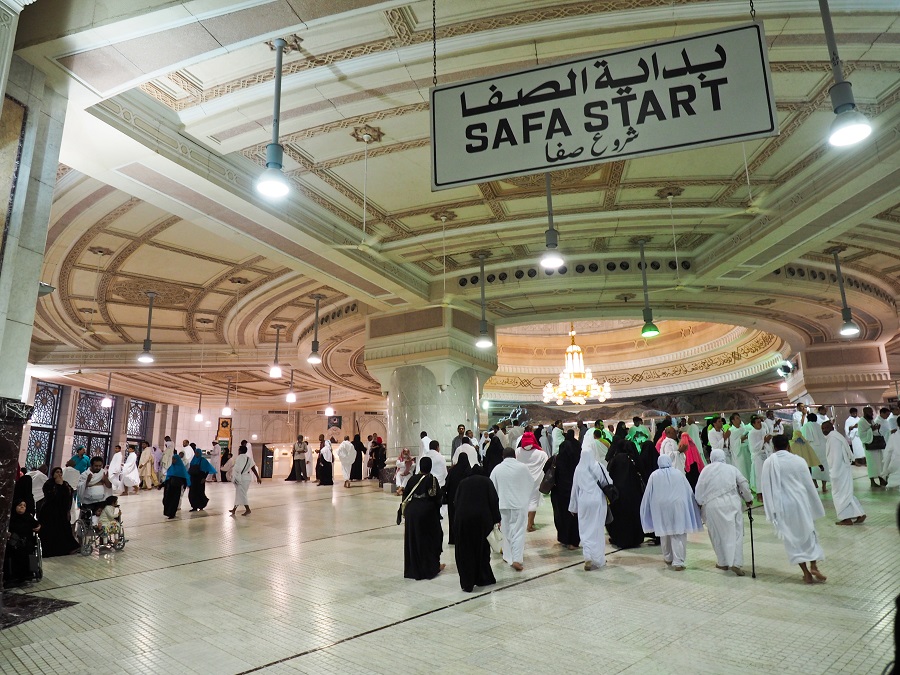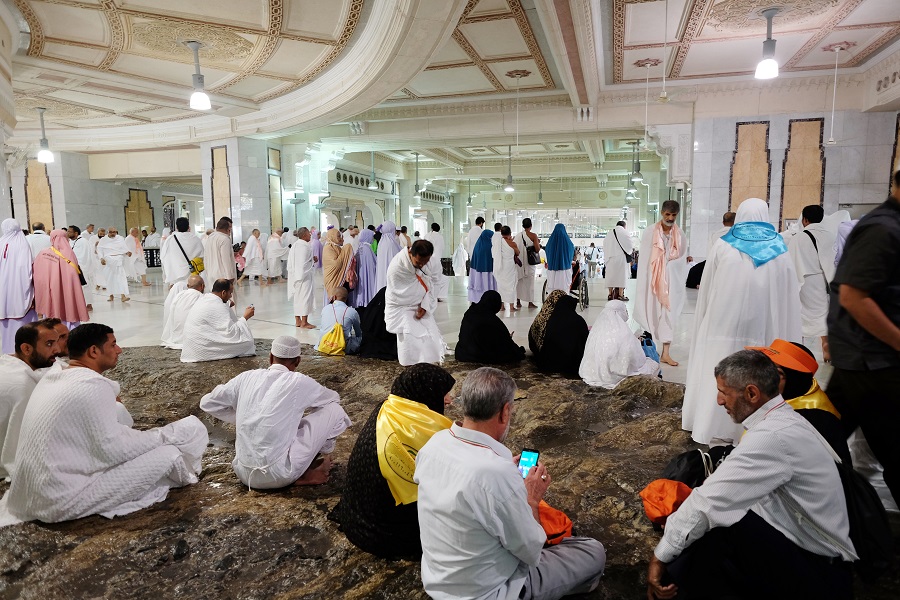Also written as Sa’i, Saee is one of the integral rites of Hajj and Umrah. The meaning of this word in Arabic is to strive, walk or pursue. Saee in Umrah refers to the ritual of walking back and forth seven times between two small hills of Safa and Marwa, which are located adjacent to the Kaaba in Masjid al-Haram.
About Saee
Umrah pilgrims perform Saee after performing Tawaf, which is circumambulating the holy Kaaba seven times. Walking from one hill to another is considered as one round of Saee. The first round should start at Safa and end at Marwa. The next lap must begin at Marwa and end at Safa. Pilgrims walk between the hills till seven laps are completed.
If pilgrims mistakenly forget their laps, they should take the lowest amount of laps they think they have completed. Also, according to the Sunnah of Hagar, there is an area, marked between Safa and Marwa, through which men are expected to run slowly and women can walk at their own pace.
The distance between Safa and Marwa is 450 metres. The total distance covered back and forth during the seven laps amounts to approximately 3.15 km.
History of Saee
Saee is performed in remembrance of the actions of Hagar, who was the wife of Prophet Ibrahim. In response to a divine revelation soon after Hagar had given birth to their son Ismail, Prophet Ibrahim brought her and Ismail to Makkah, which was a barren land at that time. After learning about the divine instruction, Hagar placed her trust in Allah. Prophet Ibrahim left some dates and water and left his wife and son behind. The resources ran out after some time. To look for water, Hagar ran back and forth between Mount Safa and Mount Marwa, and also climbed these hills.
The act of Saee is a way of paying respect to Hagar and her struggle to find water for her thirsty son. Every year, millions of pilgrims walk between Safa and Marwa hills to pay their respects while completing their pilgrimage.
The story continues with Hagar returning back to Ismail in a distressed state and finding him kicking the ground, from where water suddenly erupts. This led to the discovery of Zamzam water, which is the holy water that pilgrims drink during Hajj and Umrah, and also bring back some of it for their kin. Later, the tribe of Jurhum came across this water spring and began to settle around this place.
Significance of Saee in Umrah
The ritual of Saee depicts the ongoing struggle that a person encounters throughout his or her life, as Hajar had experienced. However, through her unwavering reliance on God, her supplications were answered and her requirements were met. For a pilgrim, Saee is a time for meditation and reflection on one’s presence in the physical world.
How to perform Saee: Step-by-Step Guide
1. Proceed to the hill of Safa, which is situated in line with the Hajar al-Aswad. Here, one should start Saee by performing Niyat (intention ) facing the Kabbah. It is Sunnah to recite the following – “Inna s-safa wa l-marwata min sha’a’iri llah(i)”. It means that indeed, Safa and Marwa are from the signs of Allah. After this, pilgrims would have to recite the following Dua – “Abda’u bima bad’allahu bihi”. This Dua says, I begin with that which Allah has begun with. These supplications are required to be only recited once before Saee and not at the beginning of each lap. It is believed that dua is accepted immensely during Saee.
2. On reaching the hill of Safa, pilgrims are required to face the direction of the Kaaba and raise their hands in supplication. Their view of the Kaaba will be obscured so make an educated guess about its location and face this direction. They don’t have to raise their hands up to their earlobes or gesture towards the Kaaba as they would have done during Tawaf.
Atop Safar, it is Sunnah to recite the following Dua – “Allahu akbar, Allahu akbar, Allahu akbar, wa lillahi l-ḥamd. La ilaha illallah wahdahu la sharika lah(u), lahu l-mulku wa lahu l-hamdu yuhyi wa yumit(u), wa huwa ‘ala kulli shay’in qadir. La ilaha illallahu wahdah(u), anjaza wa’dahu wa nasara ‘abdahu wa hazama l-ahzaba wahdah.” This Dua says – Allah is the greatest and to Allah belongs all praise. There is no deity except Allah, alone without a partner. To Him belongs the Dominion, and to Him belongs all praise. He gives life and death and He has power over everything. There is no deity except Allah alone. He fulfilled His promise, supported His slave and defeated the confederates alone.
Note: According to the Sunnah of the Prophet, pilgrims need to read the above dua a total of three times. They can also make their own supplications in between each time, and can recite any prayers or supplications of their choice during Saee.
3. From Safa, pilgrims need to move towards Marwa. Between Safa and Marwa, they will come across two sets of green fluorescent lights approximately 50 metres apart. These lights indicate the distance that Hagar ran in order to get to higher ground. These two green milepost markers are known as Milayn al-Akhdharayn. Between these two lights, it is Sunnah for men to run at a medium pace while women should continue normally.
4. Upon reaching the hill of Marwa, they must face the direction of the Kaaba and raise their hands in supplication. The same supplications should be recited at Safa. This completes one lap of Saee and returning back to Safa is considered a second lap. They need to repeat this procedure until they have completed seven laps, at which point they will be reaching the hill of Marwa.
5. At the end of Saee, it is advisable to perform two rakats of Nafil Shukrana (it is not compulsory). Here you end the holy ritual of Saee in Umrah.
For many years, there was a market situated through the route of Saee, and pilgrims had to walk in a crowded area, braving scorching heat to complete the ritual. The government of Saudi Arabia has now enlisted the hills among the territory of the Holy Kabbah and has built an air-conditioned passage with marble tiles on the floor for the comfort of the pilgrims. Also, the height of the hills of Safa and Marwa has reduced considerably over the years, making the journey much easier. Pilgrims performing Saee should keep the pace in mind for completing it as per the traditions. Saee is an indispensable element of the minor pilgrimage to Makkah. Millions of pilgrims flock to the holy city of Makkah in order to benefit from the pilgrimage and enjoy the blessings of Allah.
Saee In Umrah FAQs
What is Saee in Umrah?
Saee in Umrah refers to the ritual of walking back and forth seven times between two small hills of Safa and Marwa, adjacent to the holy Kaaba in Masjid al-Haram.
What is the significance of Saee?
The ritual of Saee depicts the ongoing struggle that a person encounters throughout his or her life, as Hajar had experienced. For a pilgrim, Saee is a time for meditation and reflection on one’s presence in the physical world.
What is the distance between Safa and Marwa?
The distance between Safa and Marwa is 450 metres. The total distance covered back and forth during the seven laps amounts to approximately 3.15 km.
What is to be done on reaching the hill of Marwa?
Upon reaching the hill of Marwa, one must face towards the direction of the holy Kaaba and raise their hands in supplication. One should recite the same supplications at Safa. This completes one lap of Saee and returning back to Safa is the second lap.
What should be done at the end of Saee?
Pilgrims can recite two rakats Nafil Shukrana at the end of Saee.
Is peforming Saee hard?
Though, seven laps can be a considerable distance, air conditioned passages are created for the ease of pilgrims.











